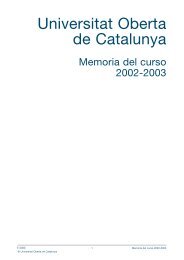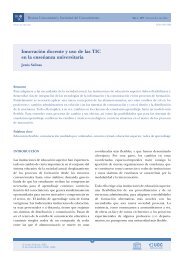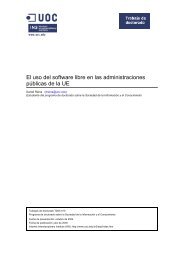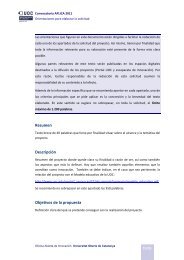e-governance and citizen information - Universitat Oberta de ...
e-governance and citizen information - Universitat Oberta de ...
e-governance and citizen information - Universitat Oberta de ...
Create successful ePaper yourself
Turn your PDF publications into a flip-book with our unique Google optimized e-Paper software.
E-<strong>governance</strong> <strong>and</strong> Citizen Information 26 Theoretical Framework. The Network Administrationmanagement practices. Low efficiency was presented as one of the explanations for <strong>citizen</strong>s'dissatisfaction. This situation should have led to searching for different options to theexclusive competition of the public sector for the provision of services to <strong>citizen</strong>s (Hugues,1998; Barzelay, 2001; Osborne <strong>and</strong> Gaebler, 1994; Peters <strong>and</strong> Pierre, 2001).Jain (2004) gathered the most common criticisms of bureaucracy <strong>de</strong>picted in the current literature,summarised in the following: Excessive adherence to the rules <strong>and</strong> inflexibility inthe application of formal rules to real situations; 'un<strong>de</strong>r-optimisation <strong>de</strong>rived from the factthat the units were aimed at objectives that were at conflict with the objectives of the organisation;resistance to change generated by the priority of the hierarchy <strong>and</strong> control thatwould favour behaviours seeking to maintain the status quo, <strong>and</strong> penalise the transformationprocess; corruption, inefficiency <strong>and</strong> concentration of power, political interferences <strong>and</strong>dissatisfaction of workers.More recently, other studies have been presented in the <strong>de</strong>fence of some elements of bureaucracy– partly as a reaction to New Public Management which, as we will explain lateron, has protected the drastic reduction of administrative mechanisms, partly based on privatisationprocesses. Therefore, Olsen (2004) explains that as an analytical concept, wecan differentiate bureaucracy with the set of organisational characteristics (hierarchy, formalisation,specialisation, etc.), with a professional staff (civil servants) <strong>and</strong> a regulated <strong>and</strong>institutional structure on which the authority is based (the legal-rational political or<strong>de</strong>r). Inthis sense, the author sees bureaucratisation as the growth of bureaucratic forms, not necessarilya <strong>de</strong>viation. Bureaucracy can be seen as a rational tool for the execution of <strong>de</strong>cisionstaken by political lea<strong>de</strong>rs, as well as a structure that <strong>de</strong>termines the authority <strong>and</strong>resources that can be used legitimately in the correct period, by the correct role <strong>and</strong> with thecorrect mechanisms <strong>and</strong> tools.Bureaucracy can also be un<strong>de</strong>rstood as an institution with its own principles <strong>and</strong> norms. Inaccordance with these premises, many of the problems <strong>de</strong>tected – such as civil servants'supposed resistance to change – <strong>de</strong>rive from the fact that the postulates of bureaucracy arenot met <strong>and</strong> the articulation between politicians <strong>and</strong> bureaucrats is not effective, which generatesconflicts between the different parties (Olsen 2004).In any case, we can highlight that, although there are a set of common parameters that allowsus to speak of a bureaucratic mo<strong>de</strong>l, there are also different traditions in which bureaucracyacquired its particular characteristics (Salvador, 2003). Anglo-Saxon countries– the United States, New Zeal<strong>and</strong>, Australia <strong>and</strong> the United Kingdom – characterised by anadministrative structure that is not so rigid <strong>and</strong> with a lower dimension than, for example,continental European structures, were the pioneers in suggesting an alternative mo<strong>de</strong>l tohttp://www.uoc.edu/in3/pic
















